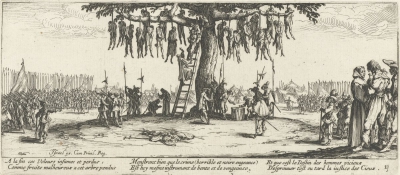The Peace of Prague (Czech: Prask mr, German: Prager Frieden), signed on 30 May 1635, ended Saxony's participation in the Thirty Years War. Other German princes subsequently joined the treaty and although the Thirty Years War continued, it is generally agreed Prague ended it as a war of religion within the Holy Roman Empire. Thereafter, the conflict was largely driven by foreign powers, including Spain, Sweden, and France.Some scholars regard the treaty merely as a step towards the terms of the 1648 Peace of Westphalia, while others recognise it as an important treaty in its own right that marked the boundaries between two historical eras. European historians generally pay more attention to the Peace of Prague than their non-European colleagues, who are more focused on Westphalia.
The Thirty Years' War was a conflict fought largely within the Holy Roman Empire from 1618 to 1648. Considered one of the most destructive wars in European history, estimates of total deaths caused by the conflict range from 4.5 to 8 million, while some areas of Germany experienced population declines of over 50%. Related conflicts include the Eighty Years' War, the War of the Mantuan Succession, the Franco-Spanish War, and the Portuguese Restoration War.
Until the 20th century, historians considered it a continuation of the German religious struggle initiated by the Reformation and ended by the 1555 Peace of Augsburg. This divided the Empire into Lutheran and Catholic states, but over the next 50 years the expansion of Protestantism beyond these boundaries gradually destabilised Imperial authority. While religion was a significant factor in starting the war, scholars generally agree that its scope and extent was driven by the contest for European dominance between Habsburgs in Austria and Spain, and the French House of Bourbon.The war began in 1618 when Ferdinand II was deposed as King of Bohemia and replaced by Frederick V of the Palatinate. Although the Bohemian Revolt was quickly suppressed, fighting expanded into the Palatinate, whose strategic importance drew in the Dutch Republic and Spain, then engaged in the Eighty Years War. Since ambitious external rulers like Christian IV of Denmark and Gustavus Adolphus of Sweden also held territories within the Empire, what began as an internal dynastic dispute was transformed into a far more destructive European conflict.
The first phase from 1618 until 1635 was primarily a civil war between German members of the Holy Roman Empire, with external powers playing supportive roles. After 1635, the Empire became one theatre in a wider struggle between France, supported by Sweden, and Spain in alliance with Emperor Ferdinand III. This concluded with the 1648 Peace of Westphalia, whose provisions included greater autonomy within the Empire for states like Bavaria and Saxony, as well as acceptance of Dutch independence by Spain. By weakening the Habsburgs relative to France, the conflict altered the European balance of power and set the stage for the wars of Louis XIV.

1635May, 30
Thirty Years' War: The Peace of Prague is signed.
Choose Another Date
Events on 1635
- 30May
Peace of Prague (1635)
Thirty Years' War: The Peace of Prague is signed. - 28Jul
Siege of Schenkenschans
In the Eighty Years' War the Spanish capture the strategic Dutch fortress of Schenkenschans. - 30Jul
Siege of Schenkenschans
Eighty Years' War: The Siege of Schenkenschans begins; Frederick Henry, Prince of Orange, begins the recapture of the strategically important fortress from the Spanish Army. - 9Oct
Roger Williams
Founder of Rhode Island Roger Williams is banished from the Massachusetts Bay Colony as a religious dissident after he speaks out against punishments for religious offenses and giving away Native American land. - 22Nov
Dutch pacification campaign on Formosa
Dutch colonial forces on Taiwan launch a pacification campaign against native villages, resulting in Dutch control of the middle and south of the island.

 English
English  español
español  français
français  português
português  русский
русский  العربية
العربية  简体中文
简体中文 